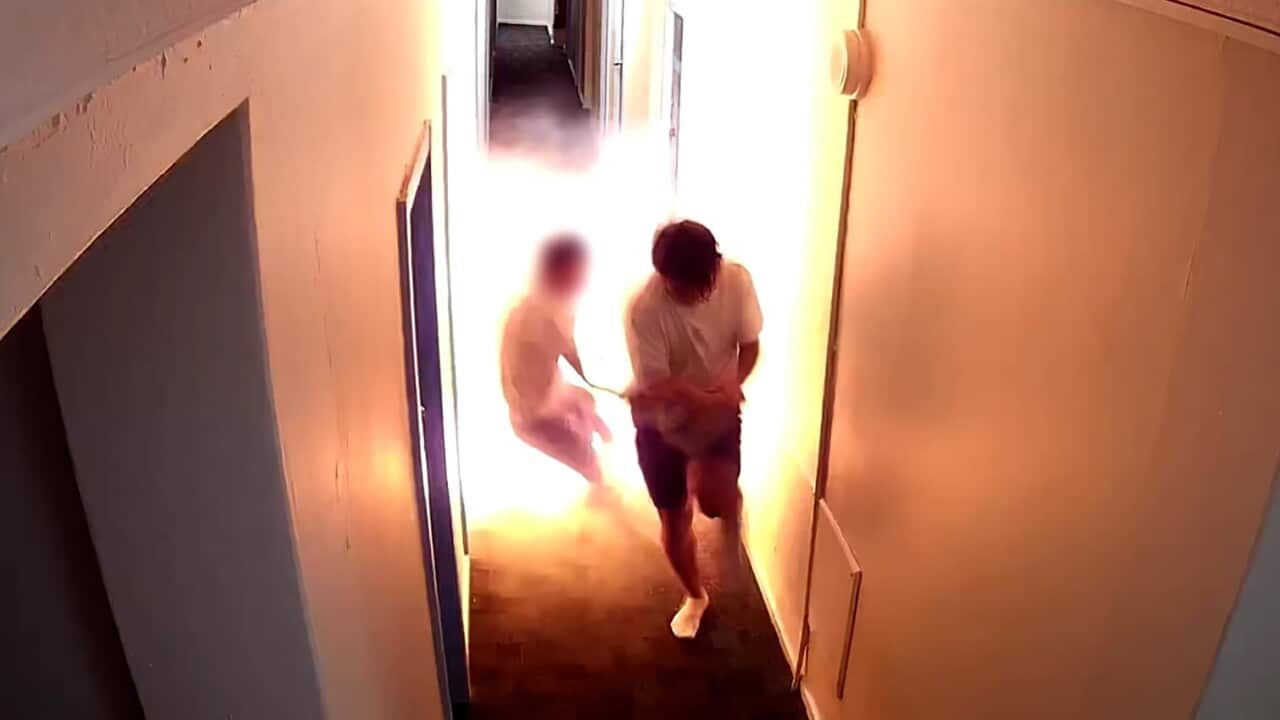Key Points
- As electric vehicles and home energy storage become more popular, lithium-ion battery fires are increasing.
- A faulty e-bike battery is believed to have caused a fire in a Sydney hostel this week.
- Australia's consumer watchdog is calling for government and industry to increase safety measures.
As lithium-ion batteries become prevalent in electric vehicles and homes, fires started by them are also becoming more common.
Two men narrowly escaped serious injury on Wednesday morning after a faulty e-bike battery exploded in a Sydney backpackers hostel, creating a large fireball.
The incident left one man with minor burns to his leg and forced 70 people to evacuate the Potts Point property while 22 firefighters extinguished the blaze.
Firefighters and NSW Police are investigating the cause of the fire — suspected to have been a faulty e-bike battery that had been connected to power.
Fire safety experts say explosions from light battery-powered vehicles such as bicycles and scooters are happening weekly in Australia and could become more common after Christmas unless consumers are given better advice.
Fire and Rescue NSW (FRNSW) responded to 114 lithium-ion battery fires between 1 January and 31 July this year, not including car-battery fires. This is trending upwards, with 165 recorded across all of 2022.
The most common type of battery fires reported were related to battery power supplies and e-bikes, scooters and ride-on toys.
The Australian Competition and Consumer Commission (ACCC) said it had received more than 230 product safety reports relating to lithium-ion batteries in the past five years alone, with one person killed in a fire believed to have been caused by the power source.
In the same period, 23 battery recalls were put in place, affecting more than 89,000 products.
What is being done to make lithium-ion batteries safer?
A new report from the ACCC has called for government and industry to develop ways for the batteries to be safely disposed of, as well as increased safety measures for consumers.
The ACCC's deputy chair Catriona Lowe said all levels of government, along with the industry and consumers, needed to work together to manage the safety of the batteries.
"We are concerned by increasing reports of lithium-ion battery fires resulting in property damage and serious injuries, including burns, chemical exposure and smoke inhalation," she said.
"We recommend that government and industry continue to develop solutions to ensure lithium-ion batteries are safely designed and can be sustainably disposed."

Five cars were completely destroyed at Sydney Airport last month by a lithium-ion battery fire. Source: AAP / Supplied/PR Image
The consumer watchdog made six recommendations in its report, calling for all levels of government to expand data collection around lithium-ion batteries, expand consumer safety messages and establish a nationally consistent framework.
It also said state and territory regulators should introduce requirements for the testing and storage of the batteries.
"Some state and territory electrical safety regulators don't have the power to regulate extra low voltage products, many of which contain lithium-ion batteries," Lowe said.
How do lithium-ion batteries work?
In simple terms, lithium-ion batteries work by pulling electrodes from one end to the other to generate energy, University of Wollongong associate professor Wei Kong Pang told SBS News.
"We can pick up pieces of energy storage, that can store electricity in chemical form, and when we charge the battery, we move the lithium-ion from the positive side to the negative side," he said.
During the lithium-ion moving around positive and negative electrodes, there is some "thermal runaway" or escaped heat generated, which is unavoidable, he said.
Every time a battery charges, it generates heat — think of your phone feeling warm after you unplug it.
How do lithium battery fires start?
"The heat is not really serious in terms of the battery's danger or safety," Pang said, but if the battery has any defects or problems, the heat becomes a risk factor for generating a fire.
"If the battery has some short-circuiting, which means when the positive side and negative side connect together for some reason, it will generate a lot more heat because a lot of currents flow in between the electrons."
Overcharging a battery can cause short-circuiting and damage to the battery.
Physical damage to the battery makes the heat more unstable and increases the fire risk.
The chemical fires produce toxic gases and are hard to extinguish.
In theory, the larger the battery, the hotter it can get and the more at risk it is, Pang said.
But though they are much larger, lithium-ion car batteries are held to much higher manufacturing standards than e-bike or scooter batteries and are considered safer.
How to avoid lithium battery fires
FRNSW says one of the first things to do is make sure you are only using batteries and chargers from reputable brands and sources and encouraged people to do research.
It pointed out that using chargers with the wrong voltage will damage the battery and could cause a fire.
People should never store or leave batteries and devices in areas where they can be exposed to heat or moisture.
It says not to leave devices such as phones, computers or charging devices in direct sunlight or in parked vehicles where they can quickly heat up.
Lithium-ion batteries are mostly imported to Australia from Europe and Asia, meaning Australia has little control over regulation of quality control and enforcing standards, Pang said.
So if more batteries were produced in Australia, it would be possible to enforce stronger regulations.
Battery management systems are improving all the time, which is positive for safety, Pang said.
When the batteries get too hot, a cooling system kicks in to drop the temperature down and decrease the risk of explosion.
Pang said scientists hope "solid state" batteries which are much safer, will become more prevalent in the future.
Additional reporting by AAP



